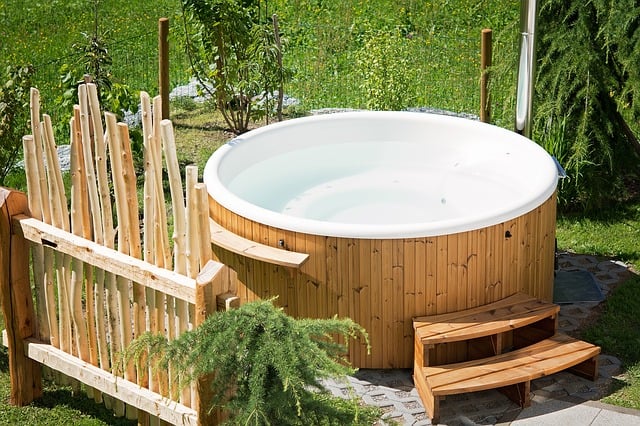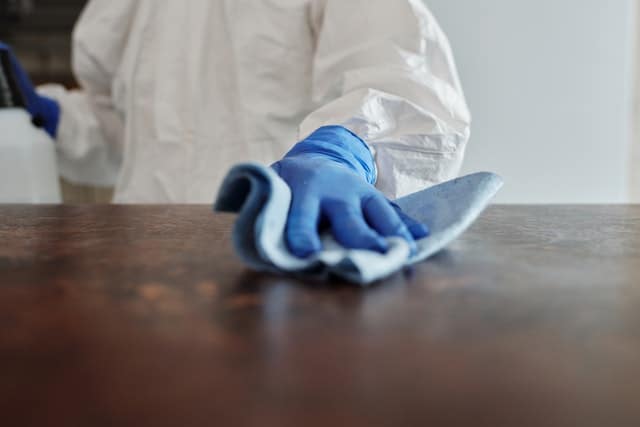Are wooden hot tubs good?
Yes, wooden hot tubs are good and have several great features. Some of these include the ability to use them all year, easy maintenance, long lifespan, relaxing aromatherapy from the natural wood, appealing aesthetic to your outdoor space, and much more. I highly recommend cedar wooden hot tubs due to their dynamic thermal properties.
Stop wasting time and money with hot tub maintenance and confusing water chemistry! The Hot Tub Handbook and Video Course will help keep your hot tub balanced, sanitized, and crystal clear all the time.
Check out my list of high-quality hot tub products to help keep your hot tub clean and running great all year long!
For treating a wood hot tub on the outside, I suggest the Natural Wood Oil from Caron & Doucet.
A few months ago I decided to go take a look at some custom-built wood hot tubs. I was amazed at the craftsmanship and wondered if wooden hot tubs are good.
I did some more research on wooden hot tubs and found out some interesting things.
We’ll discuss wooden hot tubs in detail in this article.
Let’s get started!
Are Wooden Hot Tubs Good?
Yes, wooden hot tubs are good. But the requirements for building a wooden hot tub are stringent and extensive. The type of wood could affect a hot tub’s construction quality. When selecting suitable wood, it is essential to consider the beauty, life expectancy, overall experience, and general maintenance costs.
Suppose you succeed in purchasing a wooden material that perfectly combines these elements. In that case, you may never regret buying or building the hot tub.
One of the many reasons people go for wooden hot tubs is heat insulation capacity, the beautiful appearance of the wood grains, and clarity.
Another good thing about wood is its ability to swell to maintain the hot tub’s water quality. The right type of wood is essential in preventing peeling, warping, and splintering.
How Long Does a Wooden Hot Tub Last?
Wooden hot tubs can last on average 15 to 20 years. But these hot tubs can last for longer durations, depending on the construction materials and maintenance. Of course, to prolong a wooden hot tub’s lifespan, proper water care and protecting the spa from the elements are essential.
I have seen wood hot tubs be used for forty years and are still in good condition. What is the secret? Well, it’s maintaining the wood with supplement oil or linseed oil on the outside surface.
Cleaning the inner surface is recommended. The wood’s inner surface’s cleaning materials are soda supplements, soap, and a brush. High-pressure cleaning of the hot tub could also work as long as the pressure isn’t too high. But you must avoid painting the inner or outside surfaces of the hot tub if you want to extend its life. Using proper sealant and wood oils are recommended.
Cleaning or treating your hot tub’s underside is unnecessary because it is usually designed to prevent dampness at the bottom of the spa. Often the underside of the hot tub is reinforced with rubber or some other waterproofing material.
Check out our full article on how long do hot tubs last for more information.


Stop wasting time and money with hot tub maintenance and confusing water chemistry! Get Instant access to this easy-to-use book and video course so you can spend less time cleaning and more time soaking.
Learn MoreWhen Can I Use My Wooden Hot Tub?
You can use your wooden hot tub all year round. Wooden hot tubs do not have restrictions as they give you the freedom to enjoy any month of the year. This means that you can use these tubs wherever and whenever you want. Whether it’s a cold winter or hot summer, the wooden hot tub is a great addition.
One more fantastic thing about the wooden hot tub is that it can be used with either hot or cold water. As such, you can use your tub in summer to get a freshening cold plunge or a warm, relaxing experience in the chilly winter months. Wooden hot tubs are not limited to the duration they could be used.
Check out our article on hot tub privacy if you’re looking to make your hot tub more comfortable in your outdoor space.
What Wood is Best for a Hot Tub?
The best wood for use on hot tubs is red cedar. Red cedar offers many benefits when used with the hot tub. For instance, it is known to possess the most superior thermal insulation capabilities. When the cedar hot tub is built and maintained correctly, it will offer decades of service without complications.
Unfortunately, this is not the most selected wood type in hot tub construction. People prefer Siberian spruce wood over cedar for many reasons. The Siberian Spruce is white in color and lightweight. The wood is very versatile and soft, making it easy to maintain and work with. Most people prefer the Siberian Spruce over cedar and other lumber because it allows staining in any color you wish to align in your landscape. Different types of wood like Larch and Thermal wood are limited to this feature.
The Siberian Spruce is known for its sturdiness. It’s one of the stiffest, toughest, and most robust known woods. But the main shortcoming associated with this wood is that it cannot resist rotting. Therefore, you will be required to maintain and treat spruce regularly when chosen for the hot tub construction. I have found spruce wood to be the best selection for most climates if treated and maintained correctly. The roper treatment procedure of spruce should be done 1 to 2 times a year using linseed oil.

How Do You Keep a Wooden Hot Tub Clean?
7 steps on how to keep a wooden hot tub clean:
- Proper water maintenance
- Use non-tox sanitizing solutions to keep the water clean.
- Drain and refill the hot tub every three months
- Once drained, clean the inner and outer walls with lite soap, warm water, and a brush. Don’t use anything too corrosive.
- Clean the filters regularly
- Make people take a shower before using the spa.
- Inspect the hot tub for any damage
One of the reasons I recommend keeping your wooden hot tub clean and fresh is that you can prolong its service life. The recommended duration for cleaning a wooden hot tub is usually once a month. There are cases you can constantly experience the problem of a hot tub getting dirty.
Suppose your hot tub water is constantly foamy or cloudy. In that case, I recommend checking out our articles on fixing hot tub foam and fixing cloudy hot tub water.
You should avoid cleaning your hot tub’s wooden surfaces with chlorine because it can destroy the wooden fibers, destroying the wooden material’s appearance. Wood is organic. Using chlorine for cleaning this material will destroy its organic matter.
The best materials for cleaning the wooden hot tub are a scrub brush and clean water. However, I have found that keeping the water in your hot tub balanced serves as one of the best ways to maintain your hot tub’s cleanliness.
When cleaning, you may use a terry towel for wiping the tub surfaces. Alternatively, you can use a brush for scrubbing, depending on the current condition of your hot tub. If there are rigid surfaces on the hot tub that require cleaning, put some baking soda into your terry towel and use it to wipe the surfaces.
After the cleaning process is complete, you should rinse the hot tub thoroughly with water and flush it out of the hot tub. The hot tub walls can be rinsed with warm water and a cloth if cleaned using baking soda. After rinsing the walls, give them some time to dry out before refilling the hot tub.

I recommend the E-Cloth Starter Pack for cleaning your wooden hot tub.
For treating a wood hot tub on the outside, I suggest the Natural Wood Oil from Caron & Doucet.
Wooden Hot Tubs vs. Acrylic Spas
Here are some differences between standard acrylic hot tubs and wooden hot tubs.
Comfort
Acrylic spas are superior in comfort to wooden hot tubs. They are designed with molded lounges, headrests, and bucket seats for increased comfort. But most of the wooden hot tubs are frankly and straight by the edges, offering a minimum comfort. Indeed, even the earliest wooden tub designs did not have resting benches.
Appearance
Both wood and acrylic result in an appealing design. However, the hot tub’s wooden stave and round shape produce a more Zen-like feeling. A wooden hot tub is also wrapped in wooden steps and a natural aromatherapy deck when one is soaking. Wooden hot tubs outweigh acrylic spas in terms of appearance.
Features
The features of acrylic spas are superior to wooden spas. Hot tubs are designed with waterfalls, fantastic lighting and controls, and video/audio systems. On the other hand, most wooden hot tubs are usually low-tech. However, if you’re building your own, then you can make it as high-tech as you want.
Efficiency
Acrylic spas are more efficient than wooden hot tubs. Although the wooden hot tub thickness matters in maintaining the heat, its efficiency cannot exceed acrylic spas. However, this can largely depend on the season and ambient air temperature.
Check out our full article on hot tub insulation for more information.
Maintenance
Maintenance costs are higher for wooden hot tubs than for acrylic spas. The wood exterior and interior require more maintenance services than conventional acrylic, plastic, and fiberglass hot tubs. For instance, you will be required to seal and stain the wood exterior in a frequency for a few years. Besides, the interior will require regular cleaning in a frequency of a few months.
Sanitation Requirements
When you treat the wooden hot tubs and the acrylic spas using the recommended chemical, they will become sanitary. But acrylic hot tubs have much longer pipes and hoses that increase bio-filming risk. There are minor plumbing works in wooden hot tubs, meaning that the chances to form bio-films are minimal.
The smooth surface of acrylic spas helps with maintaining a clean surface. On the other hand, the wood contains a natural antiseptic such as insects- and the rot-resistant types used in the hot tub construction. This makes the wooden material inhibit the growth of algae and bacteria on the hot tub surfaces. This means draining the wooden spa is essential for proper maintenance.
Check out our article on how to treat cloudy hot tub water for more information.
Wooden Hot Tubs Pros and Cons
Here are some Pros and Cons of wooden hot tubs.
Wooden Hot Tub Pros
The cost of a wooden hot tub is relatively cheaper than acrylic or fiberglass reinforced models.
Hot tubs constructed from oak, cedar, teak, spruce, or redwood are more appealing than those built with other materials. The hot tub’s natural material provides a richly stunning look from the wood grains, the wood colors, and the geometric space.
Wooden hot tubs include a natural, pleasant aroma while you soak. But other hot tubs will only include artificial fragrances, which you add when using the hot tub.
The wooden hot tubs have relatively long durability and strength compared to other materials like plastic.
All the wooden hot tubs have one unique property, expanding when wet and failing to shrink back to their standard shape and size when dry. This feature is essential because it ensures that all spaces are sealed and that the hot tub is leak-proof.
Check out this great article from hottubinsider.com about some more wooden hot tub pros.
Wooden Hot Tub Cons
The wooden hot tubs are bulky to move because they have many heavy components to assemble at home.
More maintenance is required for the wooden hot tubs by staining and cleaning the interior surfaces every couple of months.
The wooden hot tubs’ insulation capability is less efficient than that of the fiberglass reinforced hot tubs.
Most of the wooden hot tubs have limited features than the modern acrylic spas. Modern spas include led lights, stereos, digital controls, and waterfalls, among others.
Are Wooden Hot Tubs Good: Conclusion

I have seen that the wooden hot tubs are good because they can be used in any season and at any time of the day. Wooden hot tubs beat acrylic spas in appearance, cost, and sanitation. But the acrylic is more durable, efficient, and comfortable with more excellent features than the wooden hot tubs.
I believe that wooden hot tubs are good enough to invest in analyzing the pros and cons.
I hope you found this article on wooden hot tubs helpful.
Thanks for visiting spatoolkit.com
James Brockbank

Stop wasting time and money with hot tub maintenance and confusing water chemistry! Get Instant access to this easy-to-use book and video course so you can spend less time cleaning and more time soaking.
Learn More


